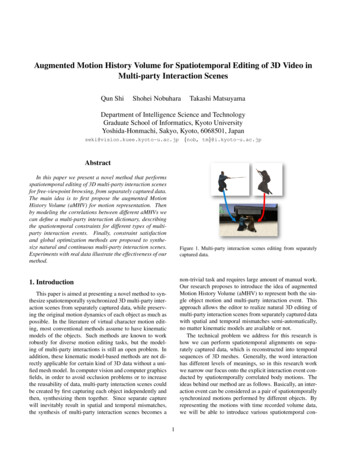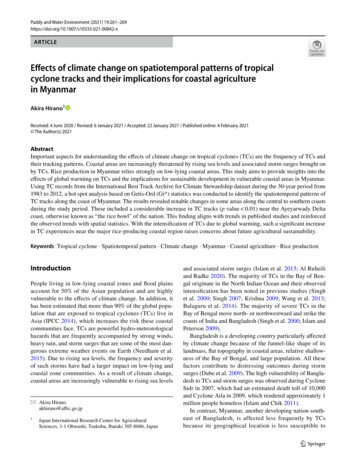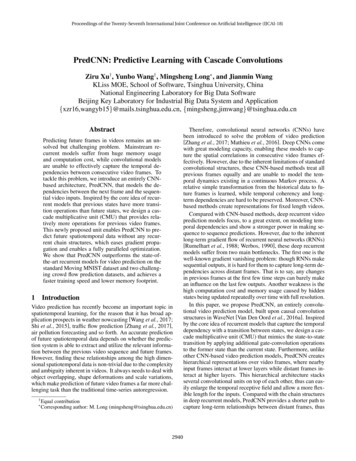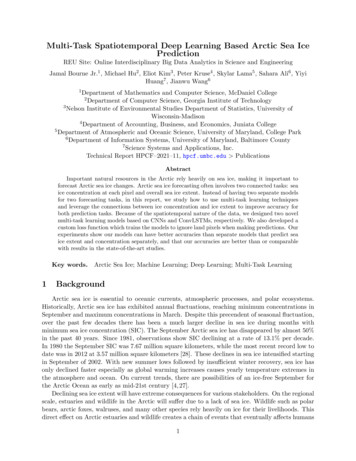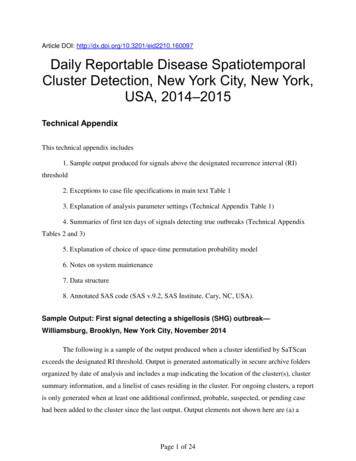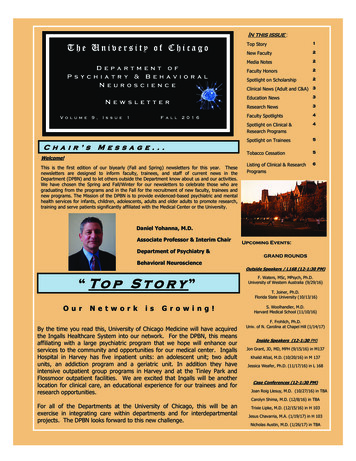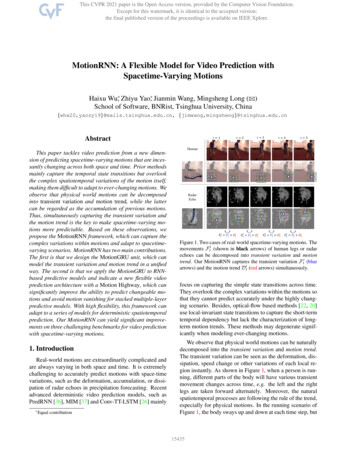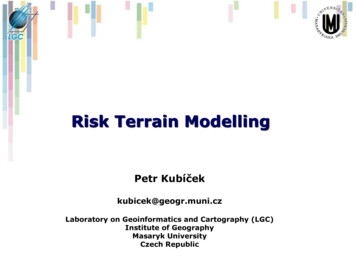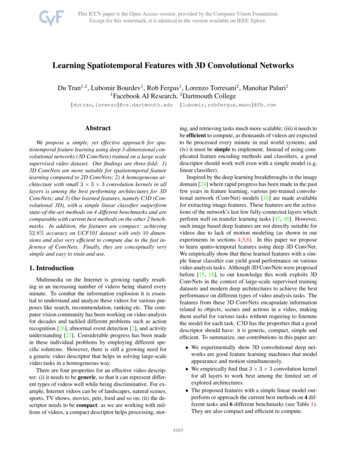
Transcription
Learning Spatiotemporal Features with 3D Convolutional NetworksDu Tran1,2 , Lubomir Bourdev1 , Rob Fergus1 , Lorenzo Torresani2 , Manohar Paluri11Facebook AI Research, 2 Dartmouth College{dutran,lorenzo}@cs.dartmouth.eduAbstractWe propose a simple, yet effective approach for spatiotemporal feature learning using deep 3-dimensional convolutional networks (3D ConvNets) trained on a large scalesupervised video dataset. Our findings are three-fold: 1)3D ConvNets are more suitable for spatiotemporal featurelearning compared to 2D ConvNets; 2) A homogeneous architecture with small 3 3 3 convolution kernels in alllayers is among the best performing architectures for 3DConvNets; and 3) Our learned features, namely C3D (Convolutional 3D), with a simple linear classifier outperformstate-of-the-art methods on 4 different benchmarks and arecomparable with current best methods on the other 2 benchmarks. In addition, the features are compact: achieving52.8% accuracy on UCF101 dataset with only 10 dimensions and also very efficient to compute due to the fast inference of ConvNets. Finally, they are conceptually verysimple and easy to train and use.1. IntroductionMultimedia on the Internet is growing rapidly resulting in an increasing number of videos being shared everyminute. To combat the information explosion it is essential to understand and analyze these videos for various purposes like search, recommendation, ranking etc. The computer vision community has been working on video analysisfor decades and tackled different problems such as actionrecognition [26], abnormal event detection [2], and activityunderstanding [23]. Considerable progress has been madein these individual problems by employing different specific solutions. However, there is still a growing need fora generic video descriptor that helps in solving large-scalevideo tasks in a homogeneous way.There are four properties for an effective video descriptor: (i) it needs to be generic, so that it can represent different types of videos well while being discriminative. For example, Internet videos can be of landscapes, natural scenes,sports, TV shows, movies, pets, food and so on; (ii) the descriptor needs to be compact: as we are working with millions of videos, a compact descriptor helps processing, stor-{lubomir,robfergus,mano}@fb.coming, and retrieving tasks much more scalable; (iii) it needs tobe efficient to compute, as thousands of videos are expectedto be processed every minute in real world systems; and(iv) it must be simple to implement. Instead of using complicated feature encoding methods and classifiers, a gooddescriptor should work well even with a simple model (e.g.linear classifier).Inspired by the deep learning breakthroughs in the imagedomain [24] where rapid progress has been made in the pastfew years in feature learning, various pre-trained convolutional network (ConvNet) models [16] are made availablefor extracting image features. These features are the activations of the network’s last few fully-connected layers whichperform well on transfer learning tasks [47, 48]. However,such image based deep features are not directly suitable forvideos due to lack of motion modeling (as shown in ourexperiments in sections 4,5,6). In this paper we proposeto learn spatio-temporal features using deep 3D ConvNet.We empirically show that these learned features with a simple linear classifier can yield good performance on variousvideo analysis tasks. Although 3D ConvNets were proposedbefore [15, 18], to our knowledge this work exploits 3DConvNets in the context of large-scale supervised trainingdatasets and modern deep architectures to achieve the bestperformance on different types of video analysis tasks. Thefeatures from these 3D ConvNets encapsulate informationrelated to objects, scenes and actions in a video, makingthem useful for various tasks without requiring to finetunethe model for each task. C3D has the properties that a gooddescriptor should have: it is generic, compact, simple andefficient. To summarize, our contributions in this paper are: We experimentally show 3D convolutional deep networks are good feature learning machines that modelappearance and motion simultaneously. We empirically find that 3 3 3 convolution kernelfor all layers to work best among the limited set ofexplored architectures. The proposed features with a simple linear model outperform or approach the current best methods on 4 different tasks and 6 different benchmarks (see Table 1).They are also compact and efficient to compute.14489
UMDObjectaction recognitionaction recognitionaction similarity labelingscene classificationscene classificationobject recognition[29]90.885.2[39]([25])75.8 (89.1)85.2 .3Table 1. C3D compared to best published results. C3D outperforms all previous best reported methods on a range of benchmarks exceptfor Sports-1M and UCF101. On UCF101, we report accuracy for two groups of methods. The first set of methods use only RGB frameinputs while the second set of methods (in parentheses) use all possible features (e.g. optical flow, improved Dense Trajectory).2. Related WorkVideos have been studied by the computer vision community for decades. Over the years various problems likeaction recognition [26], anomaly detection [2], video retrieval [1], event and action detection [30, 17], and manymore have been proposed. Considerable portion of theseworks are about video representations. Laptev and Lindeberg [26] proposed spatio-temporal interest points (STIPs)by extending Harris corner detectors to 3D. SIFT and HOGare also extended into SIFT-3D [34] and HOG3D [19] foraction recognition. Dollar et al. proposed Cuboids featuresfor behavior recognition [5]. Sadanand and Corso built ActionBank for action recognition [33]. Recently, Wang et al.proposed improved Dense Trajectories (iDT) [44] which iscurrently the state-of-the-art hand-crafted feature. The iDTdescriptor is an interesting example showing that temporalsignals could be handled differently from that of spatial signal. Instead of extending Harris corner detector into 3D, itstarts with densely-sampled feature points in video framesand uses optical flows to track them. For each tracker corner different hand-crafted features are extracted along thetrajectory. Despite its good performance, this method iscomputationally intensive and becomes intractable on largescale datasets.With recent availability of powerful parallel machines(GPUs, CPU clusters), together with large amounts of training data, convolutional neural networks (ConvNets) [28]have made a come back providing breakthroughs on visualrecognition [10, 24]. ConvNets have also been applied tothe problem of human pose estimation in both images [12]and videos [13]. More interestingly these deep networksare used for image feature learning [7]. Similarly, Zhou etal. and perform well on transferred learning tasks. Deeplearning has also been applied to video feature learning inan unsupervised setting [27]. In Le et al. [27], the authors use stacked ISA to learn spatio-temporal features forvideos. Although this method showed good results on action recognition, it is still computationally intensive at training and hard to scale up for testing on large datasets. 3DConvNets were proposed for human action recognition [15]and for medical image segmentation [14, 42]. 3D convolution was also used with Restricted Boltzmann Machinesto learn spatiotemporal features [40]. Recently, Karpathy etal. [18] trained deep networks on a large video dataset forvideo classification. Simonyan and Zisserman [36] usedtwo stream networks to achieve best results on action recognition.Among these approaches, the 3D ConvNets approachin [15] is most closely related to us. This method used a human detector and head tracking to segment human subjectsin videos. The segmented video volumes are used as inputsfor a 3-convolution-layer 3D ConvNet to classify actions. Incontrast, our method takes full video frames as inputs anddoes not rely on any preprocessing, thus easily scaling tolarge datasets. We also share some similarities with Karpathy et al. [18] and Simonyan and Zisserman [36] in termsof using full frames for training the ConvNet. However,these methods are built on using only 2D convolution and2D pooling operations (except for the Slow Fusion modelin [18]) whereas our model performs 3D convolutions and3D pooling propagating temporal information across all thelayers in the network (further detailed in section 3). We alsoshow that gradually pooling space and time information andbuilding deeper networks achieves best results and we discuss more about the architecture search in section 3.2.3. Learning Features with 3D ConvNetsIn this section we explain in detail the basic operations of3D ConvNets, analyze different architectures for 3D ConvNets empirically, and elaborate how to train them on largescale datasets for feature learning.3.1. 3D convolution and poolingWe believe that 3D ConvNet is well-suited for spatiotemporal feature learning. Compared to 2D ConvNet, 3D ConvNet has the ability to model temporal information betterowing to 3D convolution and 3D pooling operations. In3D ConvNets, convolution and pooling operations are performed spatio-temporally while in 2D ConvNets they aredone only spatially. Figure 1 illustrates the difference, 2Dconvolution applied on an image will output an image, 2Dconvolution applied on multiple images (treating them asdifferent channels [36]) also results in an image. Hence,2D ConvNets lose temporal information of the input signal right after every convolution operation. Only 3D convolution preserves the temporal information of the inputsignals resulting in an output volume. The same phenomena is applicable for 2D and 3D polling. In [36], although4490
kHkoutputHkkkLHoutputLWW(a) 2D convolutionkd LLoutputW(b) 2D convolution on multiple frames(c)3D convolutionFigure 1. 2D and 3D convolution operations. a) Applying 2D convolution on an image results in an image. b) Applying 2D convolutionon a video volume (multiple frames as multiple channels) also results in an image. c) Applying 3D convolution on a video volume resultsin another volume, preserving temporal information of the input signal.the temporal stream network takes multiple frames as input,because of the 2D convolutions, after the first convolutionlayer, temporal information is collapsed completely. Similarly, fusion models in [18] used 2D convolutions, most ofthe networks lose their input’s temporal signal after the firstconvolution layer. Only the Slow Fusion model in [18] uses3D convolutions and averaging pooling in its first 3 convolution layers. We believe this is the key reason why it performs best among all networks studied in [18]. However, itstill loses all temporal information after the third convolution layer.In this section, we empirically try to identify a good architecture for 3D ConvNets. Because training deep networks on large-scale video datasets is very time-consuming,we first experiment with UCF101, a medium-scale dataset,to search for the best architecture. We verify the findings ona large scale dataset with a smaller number of network experiments. According to the findings in 2D ConvNet [37],small receptive fields of 3 3 convolution kernels withdeeper architectures yield best results. Hence, for our architecture search study we fix the spatial receptive field to3 3 and vary only the temporal depth of the 3D convolution kernels.Notations: For simplicity, from now on we refer videoclips with a size of c l h w where c is the number ofchannels, l is length in number of frames, h and w are theheight and width of the frame, respectively. We also refer3D convolution and pooling kernel size by d k k, whered is kernel temporal depth and k is kernel spatial size.Common network settings: In this section we describethe network settings that are common to all the networks wetrained. The networks are set up to take video clips as inputsand predict the class labels which belong to 101 differentactions. All video frames are resized into 128 171. Thisis roughly half resolution of the UCF101 frames. Videosare split into non-overlapped 16-frame clips which are thenused as input to the networks. The input dimensions are3 16 128 171. We also use jittering by using randomcrops with a size of 3 16 112 112 of the input clipsduring training. The networks have 5 convolution layersand 5 pooling layers (each convolution layer is immediatelyfollowed by a pooling layer), 2 fully-connected layers anda softmax loss layer to predict action labels. The numberof filters for 5 convolution layers from 1 to 5 are 64, 128,256, 256, 256, respectively. All convolution kernels have asize of d where d is the kernel temporal depth (we will latervary the value d of these layers to search for a good 3D architecture). All of these convolution layers are applied withappropriate padding (both spatial and temporal) and stride1, thus there is no change in term of size from the inputto the output of these convolution layers. All pooling layers are max pooling with kernel size 2 2 2 (except forthe first layer) with stride 1 which means the size of outputsignal is reduced by a factor of 8 compared with the inputsignal. The first pooling layer has kernel size 1 2 2with the intention of not to merge the temporal signal tooearly and also to satisfy the clip length of 16 frames (e.g.we can temporally pool with factor 2 at most 4 times before completely collapsing the temporal signal). The twofully connected layers have 2048 outputs. We train the networks from scratch using mini-batches of 30 clips, with initial learning rate of 0.003. The learning rate is divided by10 after every 4 epochs. The training is stopped after 16epochs.Varying network architectures: For the purposes ofthis study we are mainly interested in how to aggregate temporal information through the deep networks. To searchfor a good 3D ConvNet architecture, we only vary kerneltemporal depth di of the convolution layers while keepingall other common settings fixed as stated above. We experiment with two types of architectures: 1) homogeneoustemporal depth: all convolution layers have the same kernel temporal depth; and 2) varying temporal depth: kerneltemporal depth is changing across the layers. For homogeneous setting, we experiment with 4 networks having kernel temporal depth of d equal to 1, 3, 5, and 7. We namethese networks as depth-d, where d is their homogeneoustemporal depth. Note that depth-1 net is equivalent to applying 2D convolutions on separate frames. For the varyingtemporal depth setting, we experiment two networks withtemporal depth increasing: 3-3-5-5-7 and decreasing: 75-5-3-3 from the first to the fifth convolution layer respectively. We note that all of these networks have the same sizeof the output signal at the last pooling layer, thus they havethe same number of parameters for fully connected layers.Their number of parameters is only different at convolutionlayers due to different kernel temporal depth. These differences are quite minute compared to millions of parametersin the fully connected layers. For example, any two of theabove nets with temporal depth difference of 2, only has4491
0.50.460.440.450.4clip accuracyclip accuracy0.420.350.3depth 1depth 3depth 5depth 70.250.202468# epoch1012140.40.380.360.34depth 3increasedescrease0.320.31602468# epoch10121416Figure 2. 3D convolution kernel temporal depth search. Actionrecognition clip accuracy on UCF101 test split-1 of different kernel temporal depth settings. 2D ConvNet performs worst and 3DConvNet with 3 3 3 kernels performs best among the experimented nets.17K parameters fewer or more from each other. The biggestdifference in number of parameters is between depth-1 netand depth-7 net where depth-7 net has 51K more parameters which is less than 0.3% of the total of 17.5 millions parameters of each network. This indicates that the learningcapacity of the networks are comparable and the differencesin number of parameters should not affect the results of ourarchitecture search.3.2. Exploring kernel temporal depthWe train these networks on the train split 1 of UCF101.Figure 2 presents clip accuracy of different architectures onUCF101 test split 1. The left plot shows results of nets withhomogeneous temporal depth and the right plot presents results of nets that changing kernel temporal depth. Depth3 performs best among the homogeneous nets. Note thatdepth-1 is significantly worse than the other nets which webelieve is due to lack of motion modeling. Compared to thevarying temporal depth nets, depth-3 is the best performer,but the gap is smaller. We also experiment with bigger spatial receptive field (e.g. 5 5) and/or full input resolution(240 320 frame inputs) and still observe similar behavior. This suggests 3 3 3 is the best kernel choice for3D ConvNets (according to our subset of experiments) and3D ConvNets are consistently better than 2D ConvNets forvideo classification. We also verify that 3D ConvNet consistently performs better than 2D ConvNet on a large-scaleinternal dataset, namely I380K.3.3. Spatiotemporal feature learningNetwork architecture: Our findings in the previous section indicate that homogeneous setting with convolutionkernels of 3 3 3 is the best option for 3D ConvNets.This finding is also consistent with a similar finding in 2DConvNets [37]. With a large-scale dataset, one can train a3D ConvNet with 3 3 3 kernel as deep as possible subjectto the machine memory limit and computation affordability.With current GPU memory, we design our 3D ConvNet tohave 8 convolution layers, 5 pooling layers, followed by twofully connected layers, and a softmax output layer. The network architecture is presented in figure 3. For simplicity,we call this net C3D from now on. All of 3D convolutionfilters are 3 3 3 with stride 1 1 1. All 3D poolinglayers are 2 2 2 with stride 2 2 2 except for pool1which has kernel size of 1 2 2 and stride 1 2 2with the intention of preserving the temporal information inthe early phase. Each fully connected layer has 4096 outputunits.Dataset. To learn spatiotemproal features, we trainour C3D on Sports-1M dataset [18] which is currently thelargest video classification benchmark. The dataset consistsof 1.1 million sports videos. Each video belongs to oneof 487 sports categories. Compared with UCF101, Sports1M has 5 times the number of categories and 100 times thenumber of videos.Training: Training is done on the Sports-1M train split.As Sports-1M has many long videos, we randomly extractfive 2-second long clips from every training video. Clips areresized to have a frame size of 128 171. On training, werandomly crop input clips into 16 112 112 crops for spatial and temporal jittering. We also horizontally flip themwith 50% probability. Training is done by SGD with minibatch size of 30 examples. Initial learning rate is 0.003,and is divided by 2 every 150K iterations. The optimizationis stopped at 1.9M iterations (about 13 epochs). Beside theC3D net trained from scratch, we also experiment with C3Dnet fine-tuned from the model pre-trained on I380K.Sports-1M classification results: Table 2 presentsthe results of our C3D networks compared with DeepVideo [18] and Convolution pooling [29]. We use only asingle center crop per clip, and pass it through the networkto make the clip prediction. For video predictions, we average clip predictions of 10 clips which are randomly extracted from the video. It is worth noting some setting differences between the comparing methods. DeepVideo andC3D use short clips while Convolution pooling [29] usesmuch longer clips. DeepVideo uses more crops: 4 crops perclip and 80 crops per video compared with 1 and 10 used byC3D, respectively. The C3D network trained from scratchyields an accuracy of 84.4% and the one fine-tuned fromthe I380K pre-trained model yields 85.5% at video top5 accuracy. Both C3D networks outperform DeepVideo’snetworks. C3D is still 5.6% below the method of [29].However, this method uses convolution pooling of deepimage features on long clips of 120 frames, thus it is notdirectly comparable to C3D and DeepVideo which operate on much shorter clips. We note that the difference intop-1 accuracy for clips and videos of this method is small(1.6%) as it already uses 120-frame clips as inputs. In practice, convolution pooling or more sophisticated aggregationschemes [29] can be applied on top of C3D features to improve video hit performance.C3D video descriptor: After training, C3D can be usedas a feature extractor for other video analysis tasks. To4492
Conv4b512Conv5a512Conv5b512fc7fc64096 ol3Conv2a128Pool2Pool1Conv1a64Figure 3. C3D architecture. C3D net has 8 convolution, 5 max-pooling, and 2 fully connected layers, followed by a softmax output layer.All 3D convolution kernels are 3 3 3 with stride 1 in both spatial and temporal dimensions. Number of filters are denoted in each box.The 3D pooling layers are denoted from pool1 to pool5. All pooling kernels are 2 2 2, except for pool1 is 1 2 2. Each fullyconnected layer has 4096 output units.MethodDeepVideo’s Single-Frame Multires [18]DeepVideo’s Slow Fusion [18]Convolution pooling on 120-frame clips [29]C3D (trained from scratch)C3D (fine-tuned from I380K pre-trained model)Number of Nets3 nets1 net3 net1 net1 netClip hit@142.441.970.8*44.946.1Video hit@160.060.972.460.061.1Video hit@578.580.290.884.485.2Table 2. Sports-1M classification result. C3D outperforms [18] by 5% on top-5 video-level accuracy. (*)We note that the method of [29]uses long clips, thus its clip-level accuracy is not directly comparable to that of C3D and DeepVideo.extract C3D feature, a video is split into 16 frame longclips with a 8-frame overlap between two consecutive clips.These clips are passed to the C3D network to extract fc6activations. These clip fc6 activations are averaged toform a 4096-dim video descriptor which is then followedby an L2-normalization. We refer to this representation asC3D video descriptor/feature in all experiments, unless weclearly specify the difference.What does C3D learn? We use the deconvolutionmethod explained in [46] to understand what C3D is learning internally. We observe that C3D starts by focusing onappearance in the first few frames and tracks the salient motion in the subsequent frames. Figure 4 visualizes deconvolution of two C3D conv5b feature maps with highest activations projected back to the image space. In the first example, the feature focuses on the whole person and then tracksthe motion of the pole vault performance over the rest of theframes. Similarly in the second example it first focuses onthe eyes and then tracks the motion happening around theeyes while applying the makeup. Thus C3D differs fromstandard 2D ConvNets in that it selectively attends to bothmotion and appearance. We provide more visualizations inthe supplementary material to give a better insight about thelearned feature.4. Action recognitionDataset: We evaluate C3D features on UCF101dataset [38]. The dataset consists of 13, 320 videos of 101human action categories. We use the three split setting provided with this dataset.Classification model: We extract C3D features and input them to a multi-class linear SVM for training models.We experiment with C3D descriptor using 3 different nets:C3D trained on I380K, C3D trained on Sports-1M, and C3Dtrained on I380K and fine-tuned on Sports-1M. In the mul-tiple nets setting, we concatenate the L2-normalized C3Ddescriptors of these nets.Baselines: We compare C3D feature with a few baselines: the current best hand-crafted features, namely improved dense trajectories (iDT) [44] and the popular-useddeep image features, namely Imagenet [16], using Caffe’sImagenet pre-train model. For iDT, we use the bag-of-wordrepresentation with a codebook size of 5000 for each featurechannel of iDT which are trajectories, HOG, HOF, MBHx,and MBHy. We normalize histogram of each channel separately using L1-norm and concatenate these normalized histograms to form a 25K feature vector for a video. For Imagenet baseline, similar to C3D, we extract Imagenet fc6feature for each frame, average these frame features to makevideo descriptor. A multi-class linear SVM is also used forthese two baselines for a fair comparison.Results: Table 3 presents action recognition accuracyof C3D compared with the two baselines and current bestmethods. The upper part shows results of the two baselines. The middle part presents methods that use only RGBframes as inputs. And the lower part reports all current bestmethods using all possible feature combinations (e.g. optical flows, iDT).C3D fine-tuned net performs best among three C3D netsdescribed previously. The performance gap between thesethree nets, however, is small (1%). From now on, we referto the fine-tuned net as C3D, unless otherwise stated. C3Dusing one net which has only 4, 096 dimensions obtains anaccuracy of 82.3%. C3D with 3 nets boosts the accuracyto 85.2% with the dimension is increased to 12, 288. C3Dwhen combined with iDT further improves the accuracy to90.4%, while when it is combined with Imagenet, we observe only 0.6% improvement. This indicates C3D can wellcapture both appearance and motion information, thus thereis no benefit to combining with Imagenet which is an ap4493
Figure 4. Visualization of C3D model, using the method from [46]. Interestingly, C3D captures appearance for the first few frames butthereafter only attends to salient motion. Best viewed on a color screen.Accuracy t linear SVMiDT w/ BoW linear SVMDeep networks [18]Spatial stream network [36]LRCN [6]LSTM composite model [39]C3D (1 net) linear SVMC3D (3 nets) linear SVMiDT w/ Fisher vector [31]Temporal stream network [36]Two-stream networks [36]LRCN [6]LSTM composite model [39]Conv. pooling on long clips [29]LSTM on long clips [29]Multi-skip feature stacking [25]C3D (3 nets) iDT linear 50400450500Number of dimensionsFigure 5. C3D compared with Imagenet and iDT in low dimensions. C3D, Imagenet, and iDT accuracy on UCF101 using PCAdimensionality reduction and a linear SVM. C3D outperforms Imagenet and iDT by 10-20% in low dimensions.Table 3. Action recognition results on UCF101. C3D comparedwith baselines and current state-of-the-art methods. Top: simple features with linear SVM; Middle: methods taking only RGBframes as inputs; Bottom: methods using multiple feature combinations.pearance based deep feature. On the other hand, it is beneficial to combine C3D with iDT as they are highly complementary to each other. In fact, iDT are hand-crafted featuresbased on optical flow tracking and histograms of low-levelgradients while C3D captures high level abstract/semanticinformation.C3D with 3 nets achieves 85.2% which is 9% and 16.4%better than the iDT and Imagenet baselines, respectively.On the only RGB input setting, compared with CNN-basedapproaches, Our C3D outperforms deep networks [18] andspatial stream network in [36] by 19.8% and 12.6%, respectively. Both deep networks [18] and spatial stream networkin [36] use AlexNet architecture. While in [18], the net isfine-tuned from their model pre-trained on Sports-1M, spatial stream network in [36] is fine-tuned from Imagenet pretrained model. Our C3D is different from these CNN-baseImagenetC3DFigure 6. Feature embedding. Feature embedding visualizationsof Imagenet and C3D on UCF101 dataset using t-SNE [43]. C3Dfeatures are semantically separable compared to Imagenet suggesting that it is a better feature for videos. Each clip is visualized as apoint and clips belonging to the same action have the same color.Best viewed in color.methods in term of network architecture and basic operations. In addition, C3D is trained on Sports-1M and used asis without any finetuning. Compared with Recurrent NeuralNetworks (RNN) based methods, C3D outperforms Longterm Recurrent Convolutional Networks (LRCN) [6] andLSTM composite model [39] by 14.1% and 9.4%, respectively. C3D with only RGB input still outperforms thesetwo RNN-based methods when they used both optical flowsand RGB as well as the temporal stream network in [36].4494
5. Action Similarity LabelingDataset: The ASLAN dataset consists of 3, 631 videosfrom 432 action classes. The task is to predict if a givenpair of videos belong to the same or different action. Weuse the prescribed 10-fold cross validation with the splitsprovided with the dataset. This problem is different fromaction recognition, as the task focuses on predicting actionsimilarity not the actual action label. The task is quite challenging because the test set contains videos of “never-seenbefore” actions.Features: We split videos into 16-frame clips with anoverlap of 8 frames. We extract C3D features: prob, fc7,fc6, pool5 for each clip. The features for videos are computed by averaging the clip features separately for each typeof feature, followed by an L2 normalization.Classification model: We follow the same setup usedin [21]. Given a pair of videos, we compute the 12 different10.90.8true positive rateHowever, C3D needs to be combined with iDT to outperform two-stream networks [36], the other iDT-based methods [31, 25], and the method that focuses on long-term modeling [29]. Apart from the promising numbers, C3D alsohas the advantage of simplicity compared to the other methods.C3D is compact: In order to evaluate the compactnessof C3D features we use PCA to project the features intolower dimensions and report the classification accuracy ofthe projected features on UCF101 [38] using a
and videos [13]. More interestingly these deep networks are used for image feature learning [7]. Similarly, Zhou et al. and perform well on transferred learning tasks. Deep learning has also been applied to video feature learning in an unsupervised setting [27]. In Le et al. [27], the au-thors use stacked ISA to learn spatio-temporal features .
